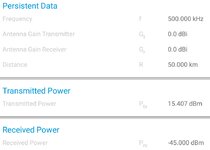Minchuu
Junior Member level 1
Hello!
I have a 4vpp signal at 500 kHz that needs to be transmitted at a max distance of 50km. Therefore, it needs to go through a transistor power amplifier that will also drive a 50ohm load (theoretically, the antenna). The bit rate will be 50 kbps. The receiver sensitivity at the end of the 50km distance is -50 dBm.
As a newbie student at this kind of topic, I am at lost how to choose what type of amplifier shall I choose, and what exactly am I designing. I apologize if I sound stupid TT^TT, but I cannot seem to connect how to choose the amplifier and what is the gain needed based from the weird specifications given. Also, everything will only be simulated so I don't need good results in real life, only that it works optimally in simulations.
Any guidance on this matter will be very much appreciated. Also, if you guys have any power amplifier analog circuit schematics that you can share that will do the bare minimum of the specifications, it will also be very much appreciated also.
Thank you very much!
I have a 4vpp signal at 500 kHz that needs to be transmitted at a max distance of 50km. Therefore, it needs to go through a transistor power amplifier that will also drive a 50ohm load (theoretically, the antenna). The bit rate will be 50 kbps. The receiver sensitivity at the end of the 50km distance is -50 dBm.
As a newbie student at this kind of topic, I am at lost how to choose what type of amplifier shall I choose, and what exactly am I designing. I apologize if I sound stupid TT^TT, but I cannot seem to connect how to choose the amplifier and what is the gain needed based from the weird specifications given. Also, everything will only be simulated so I don't need good results in real life, only that it works optimally in simulations.
Any guidance on this matter will be very much appreciated. Also, if you guys have any power amplifier analog circuit schematics that you can share that will do the bare minimum of the specifications, it will also be very much appreciated also.
Thank you very much!
Last edited:
